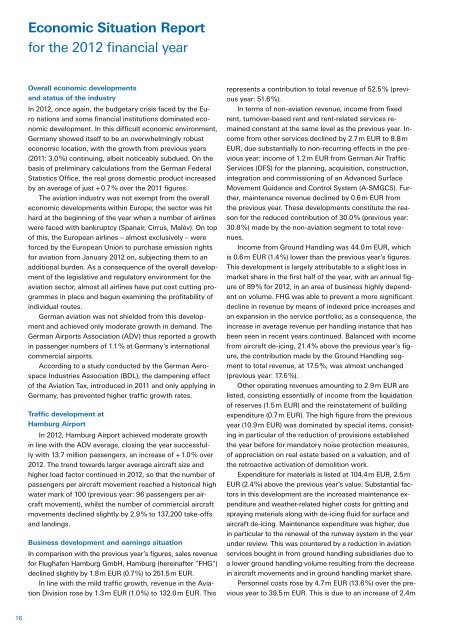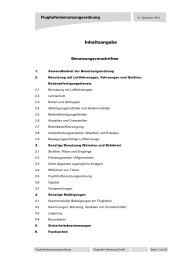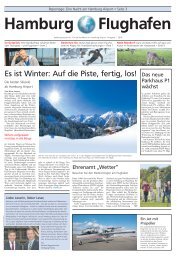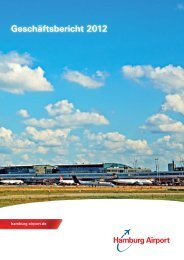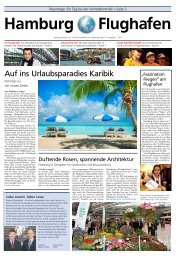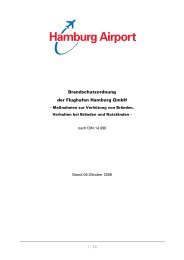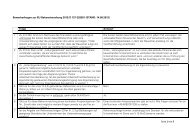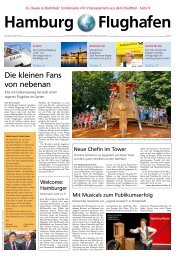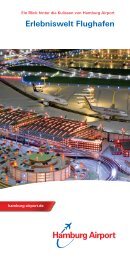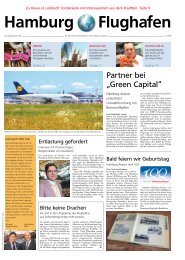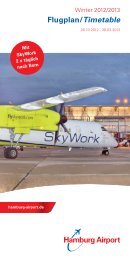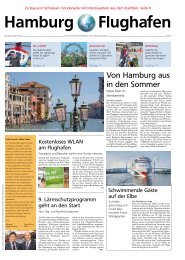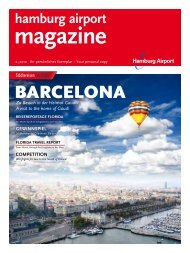Annual Report 2012 (PDF) - Hamburg
Annual Report 2012 (PDF) - Hamburg
Annual Report 2012 (PDF) - Hamburg
Create successful ePaper yourself
Turn your PDF publications into a flip-book with our unique Google optimized e-Paper software.
Economic Situation <strong>Report</strong><br />
for the <strong>2012</strong> financial year<br />
Overall economic developments<br />
and status of the industry<br />
In <strong>2012</strong>, once again, the budgetary crisis faced by the Euro<br />
nations and some financial institutions dominated economic<br />
development. In this difficult economic environment,<br />
Germany showed itself to be an overwhelmingly robust<br />
economic location, with the growth from previous years<br />
(2011: 3.0 %) continuing, albeit noticeably subdued. On the<br />
basis of preliminary calculations from the German Federal<br />
Statistics Office, the real gross domestic product increased<br />
by an average of just + 0.7 % over the 2011 figures.<br />
The aviation industry was not exempt from the overall<br />
economic developments within Europe; the sector was hit<br />
hard at the beginning of the year when a number of airlines<br />
were faced with bankruptcy (Spanair, Cirrus, Malév). On top<br />
of this, the European airlines – almost exclusively – were<br />
forced by the European Union to purchase emission rights<br />
for aviation from January <strong>2012</strong> on, subjecting them to an<br />
additional burden. As a consequence of the overall development<br />
of the legislative and regulatory environment for the<br />
aviation sector, almost all airlines have put cost cutting programmes<br />
in place and begun examining the profitability of<br />
individual routes.<br />
German aviation was not shielded from this development<br />
and achieved only moderate growth in demand. The<br />
German Airports Association (ADV) thus reported a growth<br />
in passenger numbers of 1.1 % at Germany’s international<br />
commercial airports.<br />
According to a study conducted by the German Aerospace<br />
Industries Association (BDL), the dampening effect<br />
of the Aviation Tax, introduced in 2011 and only applying in<br />
Germany, has prevented higher traffic growth rates.<br />
Traffic development at<br />
<strong>Hamburg</strong> Airport<br />
In <strong>2012</strong>, <strong>Hamburg</strong> Airport achieved moderate growth<br />
in line with the ADV average, closing the year successfully<br />
with 13.7 million passengers, an increase of + 1.0 % over<br />
<strong>2012</strong>. The trend towards larger average aircraft size and<br />
higher load factor continued in <strong>2012</strong>, so that the number of<br />
passengers per aircraft movement reached a historical high<br />
water mark of 100 (previous year: 96 passengers per aircraft<br />
movement), whilst the number of commercial aircraft<br />
movements declined slightly by 2.9 % to 137,200 take-offs<br />
and landings.<br />
Business development and earnings situation<br />
In comparison with the previous year’s figures, sales revenue<br />
for Flughafen <strong>Hamburg</strong> GmbH, <strong>Hamburg</strong> (hereinafter “FHG”)<br />
declined slightly by 1.8 m EUR (0.7 %) to 251.5 m EUR.<br />
In line with the mild traffic growth, revenue in the Aviation<br />
Division rose by 1.3 m EUR (1.0 %) to 132.0 m EUR. This<br />
represents a contribution to total revenue of 52.5 % (previous<br />
year: 51.6 %).<br />
In terms of non-aviation revenue, income from fixed<br />
rent, turnover-based rent and rent-related services remained<br />
constant at the same level as the previous year. Income<br />
from other services declined by 2.7 m EUR to 8.8 m<br />
EUR, due substantially to non-recurring effects in the previous<br />
year: income of 1.2 m EUR from German Air Traffic<br />
Services (DFS) for the planning, acquisition, construction,<br />
integration and commissioning of an Advanced Surface<br />
Movement Guidance and Control System (A-SMGCS). Further,<br />
maintenance revenue declined by 0.6 m EUR from<br />
the previous year. These developments constitute the reason<br />
for the reduced contribution of 30.0 % (previous year:<br />
30.8 %) made by the non-aviation segment to total revenues.<br />
Income from Ground Handling was 44.0 m EUR, which<br />
is 0.6 m EUR (1.4 %) lower than the previous year’s figures.<br />
This development is largely attributable to a slight loss in<br />
market share in the first half of the year, with an annual figure<br />
of 89 % for <strong>2012</strong>, in an area of business highly dependent<br />
on volume. FHG was able to prevent a more significant<br />
decline in revenue by means of indexed price increases and<br />
an expansion in the service portfolio; as a consequence, the<br />
increase in average revenue per handling instance that has<br />
been seen in recent years continued. Balanced with income<br />
from aircraft de-icing, 21.4 % above the previous year’s figure,<br />
the contribution made by the Ground Handling segment<br />
to total revenue, at 17.5 %, was almost unchanged<br />
(previous year: 17.6 %).<br />
Other operating revenues amounting to 2.9 m EUR are<br />
listed, consisting essentially of income from the liquidation<br />
of reserves (1.5 m EUR) and the reinstatement of building<br />
expenditure (0.7 m EUR). The high figure from the previous<br />
year (10.9 m EUR) was dominated by special items, consisting<br />
in particular of the reduction of provisions established<br />
the year before for mandatory noise protection measures,<br />
of appreciation on real estate based on a valuation, and of<br />
the retroactive activation of demolition work.<br />
Expenditure for materials is listed at 104.4 m EUR, 2.5 m<br />
EUR (2.4 %) above the previous year’s value. Substantial factors<br />
in this development are the increased maintenance expenditure<br />
and weather-related higher costs for gritting and<br />
spraying materials along with de-icing fluid for surface and<br />
aircraft de-icing. Maintenance expenditure was higher, due<br />
in particular to the renewal of the runway system in the year<br />
under review. This was countered by a reduction in aviation<br />
services bought in from ground handling subsidiaries due to<br />
a lower ground handling volume resulting from the decrease<br />
in aircraft movements and in ground handling market share.<br />
Personnel costs rose by 4.7 m EUR (13.6 %) over the previous<br />
year to 39.5 m EUR. This is due to an increase of 2.4m<br />
16


